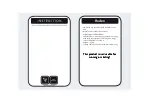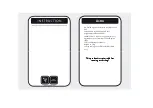
23
8.0 M a inten a n c e
8.3 Maintenance work
8.3.1 Cleaning
To be performed by operator
CAUTION
Damage due to incorrect cleaning!
Therefore:
• Do not use any aggressive cleaning agents. Water used forclean-
ing including the chemical additives must be pH-neutral.
• Liquids must not touch the actuator during the retraction or ex-
tension.
• Only use additional cleaning materials listed by the manufacturer.
• No steam jets or pressure washers may be used for cleaning.
• Other cleaning agents or cleaning devices may only be utilized
with the manufacturer’s approval.
Clean line actuator:
1. Separate the actuator from the energy supply.
2. Clean dirty parts with a damp cloth.
8.3.2 Inspections and readings
To be performed by professional electrician
• The inspections and readings must be performed as re-
quired by the applicable standards and regulations. The list
of the applicable standards can be found in the appendix.
• The inspections must be documented (⮑ Service Log).
Service log
• Complete the following entries in the service log:
• Name of the executing body (company, department).
• Names of the staff on duty.
• Identification of the actuator/system (type, serial number,
inventory number) and the respective accessories.
• Completed inspections and readings.
• Scope and results of the inspections.
• Measuring method, measuring device, measuring results
for readings.
• Overall assessment.
• Date and signature of the assessing person; personal cod-
ing is a viable alternative for IT applications.
8.3.3 Check of visual condition
To be performed by qualified personnel
1. Separate the actuator from the energy supply.
2. Check the following structural components for visible ex-
ternal damage:
Fig. 8
3. Notify processor or Ewellix in case of damage
4. If there is no damage and the processors/manufacturer
has not communicated any concerns, reconnect the ac-
tuator to the power supply.
8.4 Measures after
completed maintenance
Upon completion of the maintenance work, the following
steps have to be performed prior to restarting the actuator.
1. Check all previously loosened screw connections for a
tight fit.
2. Ensure that all tools, material and other equipment used
during maintenance have been removed from the work
area.
3. Clean work area and remove potential spills such as liq-
uids, processing material or similar.
4. Ensure that all safety measures of the system work prop-
erly without a problem.
5. Check to be sure that all actuator and system functions
are operating correctly.
6. Document the the maintenance in the service log.
1. Check connecting cables for cracks, cuts and
pinched sections
2. Check hinge hole for cracks, deformation and bro-
ken pieces
3. Check stainless steel tube for scratches and inden-
tations
3
2
2
1
Summary of Contents for CAHB-20E
Page 2: ......






































